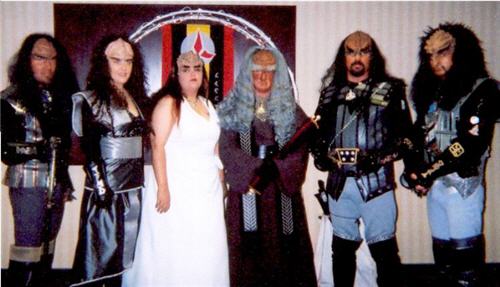"What's going on here?" I asked, moderately interested.
"Oh, we're setting up to play Artemis," Don replied.
I, of course, inquired about the game. The answer I received, I kid you not, BLEW MY MIND. I'm sure some people out there have already heard about this. If you haven't however, allow me to give you a quick synopsis of what it is.
If you've ever seen an episode of Star Trek, than you're familiar with how the bridge of a typical starship is comprised of several people, each at a post that's essential to the functioning of the ship. Well, that's what Artemis is. Artemis allows a group of people to simulate what it's like to each take a station on the bridge of a Star Trek-esque starship and make it work as they go through missions.
The stations available to fill are:
Weapons: The weapons officer is in charge of, duh, firing the ship's various weapons systems. The game offers "beams" (which, let's be honest, are stand-ins for phasers), mines, torpedoes, and the powerful "nukes". The weapons officer also has the ability to turn ship's power into more torpedoes or torpedoes into more power. The cool thing about the interface for the weapons officer is that, when using the beams, they can target specific parts of the enemy ship to cripple specific systems. THAT is cool.
Helm: The helm officer is, essentially, the pilot. They make the ship go. They make the ship turn. The control speed, direction, etc. This is important because the pilot needs to be sure that, during a fight, the ship maneuvers as much away from enemy fire as possible while, at the same time, making sure the ship's weapons officer can still fire upon them. I didn't get to look in-detail at the helm interface, but it seemed fairly straight-forward.
Science: The science officer in in-charge of a LOT of different aspects. First and foremost, they have control of the scanners and the information they provide. This comes into play when an enemy ship's shield frequency is required to bypass their defenses. They also are the ones that give the bearings for navigation to the helm officer. Essentially, anything scan-related or navigationally supplementary falls under the science officer's control.
Communication: The communication officer is the one that takes incoming calls. They also hail enemy ships to surrender when in combat. Contacting friendly star bases and ally ships also falls within the communication officer's control This is important because the communication officer is the one that communicates the orders to friendly bases and ships to do things like "make us more ammo" or "assist us in battle".
Engineering: The engineering officer (my role) is the one that delegates where the ship's power goes at any given point. They have the option of bumping the beam power, or the engines, or the maneuvering, or any of the other seven systems in the ship. They do this through a careful balance of coolant resources (which keep high-running systems from overheating) and power application to optimize the ship for certain scenarios. To save these settings, the engineering officer is allowed ten presets in which they can record a setting and jump back to it at the click of a button. On top of all that, the engineering officer monitors any damage to the ship and controls the three damage control teams to go and fix them.
Captain: The captain is the only role in the game that does not require an actual computer to play. The captain sits back and gives the other officers orders to follow during the scenarios. We were fortunate to have have our friend Jim be the captain. Initially, I thought the role of captain would be a boring one, but when the game got going and Jim started coordinating the rest of us, it actually felt like a cooperative starship effort.
It took a bit of tweaking and experimenting before we all started to get the hang of our various systems, but once we actually figured out everything we were doing, it got REALLY exciting. We were engaging groups of enemy ships, encountering unknown space entities, saving space bases from attack, and generally hopping about the universe being badasses.
 |
| Unfortunately, green women aren't part of the experience. |
 |
| Again. |
Make it so!







